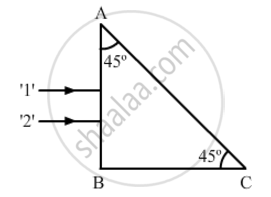Advertisements
Advertisements
प्रश्न
Answer the following question.
In the diffraction due to a single slit experiment, the aperture of the slit is 3 mm. If monochromatic light of wavelength 620 nm is incident normally on the slit, calculate the separation between the first order minima and the 3rd order maxima on one side of the screen. The distance between the slit and the screen is 1.5 m.
उत्तर
As we know that the angular position of the minimum intensity on the screen is given as
`asintheta = Nlambda`
so we have for first-order minimum
`(3 xx 10^-3)sin theta = 620 xx 10^-9`
`theta_1 = 0.0118^circ`
now similarly for 3rd order minimum
`atheta_2 = 3lambda`
`(3 xx 10^-3)sintheta_2 = 3(620 xx 10^-9)`
`theta_2 = 0.0355^circ`
now the angular seperation between two minimum
`Deltatheta = 0.0355 - 0.0118`
`Deltatheta = 0.0237^circ`
So the distance between two minimum is
`d = LDeltatheta`
`d = 1.5(0.0237 xx pi/180)`
d = 0.62 mm.
संबंधित प्रश्न
Two monochromatic rays of light are incident normally on the face AB of an isosceles right-angled prism ABC. The refractive indices of the glass prism for the two rays '1' and '2' are respectively 1.35 and 1.45. Trace the path of these rays after entering the prism.

When monochromatic light travels from a rarer to a denser medium, explain the following, giving reasons:
(i) Is the frequency of reflected and refracted light same as the frequency of incident light?
(ii) Does the decrease in speed imply a reduction in the energy carried by light wave?
When monochromatic light is incident on a surface separating two media, why does the refracted light have the same frequency as that of the incident light?
Obtain the conditions for the bright and dark fringes in diffraction pattern due to a single narrow slit illuminated by a monochromatic source.
Explain clearly why the secondary maxima go on becoming weaker with increasing.
State Huygen’s principle. Using this principle explain how a diffraction pattern is obtained on a screen due to a narrow slit on which a narrow beam coming from a `=> n = (vlamda)/(vlamda_omega)`monochromatic source of light is incident normally.
If a monochromatic source of light is replaced by white light, what change would you observe in the diffraction pattern?
Which of the following sources provides the best monochromatic light?
Monochromatic light of wavelength 650 nm falls normally on a slit of width 1.3 x 10-4 cm and the resulting Fraunhofer diffraction is obtained on a screen. Find the angular width of the . central maxima.
Find the angle of incidence at which a ray of monochromatic light should be incident on the first surface AB of a regular glass prism ABC so that the emergent ray grazes the adjacent surface AC. (Refractive Index of glass = 1 .56)
Monochromatic fight of wavelength 198 nm is incident on the surface of a metallic cathode whose work function is 2.5 eV How much potential difference must be applied between the cathode and the anode of a photocell to just stop the photocurrent from flowing?
